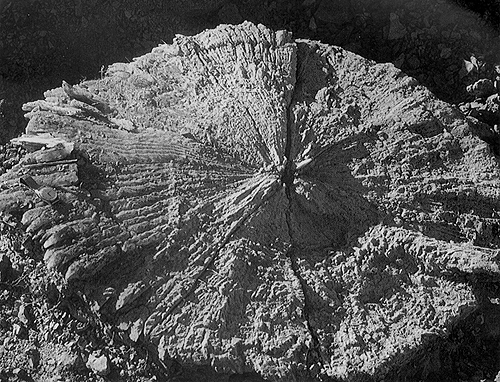
Rosette-shaped gypsum concretion
Plate 175

Rosette-shaped gypsum concretion
Plate 175
This large and spectacular concretion (see watch on left for scale) has a discoidal shape and a radial growth pattern, the "rays" being made of saberlike selenite crystals. The crystals are turbid for the presence of clay impurities. Similar concretion, called rosettes or cockades, occur more commonly on a much smaller scale (millimeters to centimeters). They are found along joints and bedding planes (i.e., physical discontinuities in a rock mass), which explains their flat shape.
This gigantic example was collected in Pliocene fossiliferous clays of the Siena area in central Italy. The obvious conclusion is that this diagenetic form of gypsum has nothing to do with evaporites, unless sulfate ions deriving from a leached evaporitic formation circulate through the rocks. But it is not necessary to have a sulfate source: the SO4-- ions can derive from the oxidation, possibly helped by bacteria, of sulfides (which are commonly contained in normal marine muds). The calcium is supplied by the carbonate skeletons of fossils.
Joint-filling gypsum is usually made of elongate, fibrous crystals oriented perpendicularly or obliquely to the joint surfaces (see plate 176 and color picture 29); this variety of secondary gypsum has a white color and a silky gloss, and is called sericolite. One can wonder why rosette concretions, too, are not made of sericolite. Actually, they were. Only afterward, sericolite recrystallized into twinned selenite; fibrous crystals, forming a double, welded palisade, are still recognizable near the center of the concretion.
| Photo: A. Ferrieri 1992. |